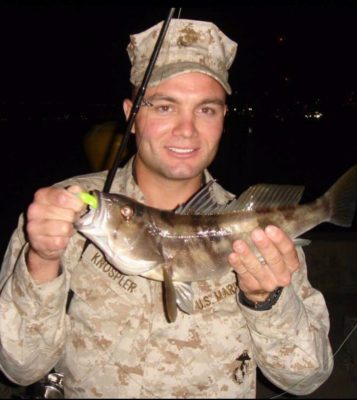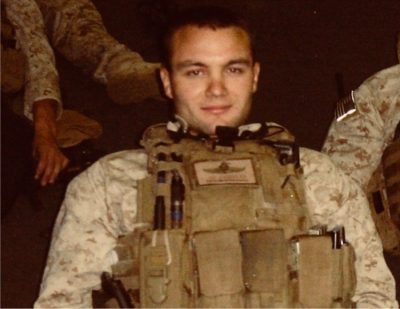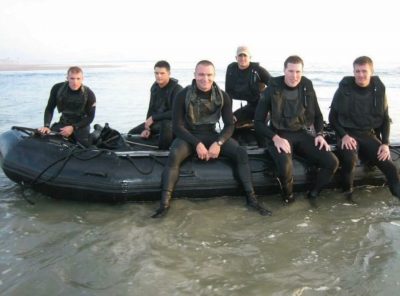Veteran Fights For Freedom In Wyoming
Stand Your Ground Case
by Matthew M. Burke
Former U.S. Marine and Iraq war veteran John Henry Knospler, Jr. admitted to killing James Kade Baldwin outside a Casper, Wyoming, strip club in the early morning hours of Oct. 4, 2013, but claims he shot the 24-year-old Casper native in self-defense.
Knospler says he was sleeping in his car rather than drive intoxicated from the bar when an angry Baldwin inexplicably bashed in his window and violently attacked him.
Despite evidence that appeared to back Knospler’s claims, the 38-year-old was convicted of second-degree murder on Dec. 23, 2014, and sentenced to up to 50 years in prison. His sole appeal was denied by the Wyoming Supreme Court in 2016.
Knospler has vehemently maintained his innocence over the years, and he recently filed a motion seeking to vacate his conviction based primarily on new forensic evidence. It is largely seen as what could be his last and best chance of getting a new trial.
Knospler’s case has been largely ignored in the greater national Second Amendment and stand-your-ground debates. Race does not appear to be a factor in the case, as both Knospler and Baldwin are white.
Wyoming law allows someone to use deadly force in self-defense if they believe they are in imminent danger of death or serious bodily harm.
The burden is on the state to prove beyond a reasonable doubt that a defendant did not act in self-defense.
Knospler grew up on a small farm in East Stroudsburg, Pennsylvania — the oldest of three siblings. There, he, along with his father, John Sr.; mother, Patricia; brother, Jacob; and sister, Leighanne, lived a rustic lifestyle. They played outdoors, raised livestock and grew their own vegetables. They also fished, and Knospler’s father hunted.

“We went on trips. My parents thought it was really important that we saw certain things in the country,” Knospler said. “They took us to Gettysburg, to the Vietnam Veterans Memorial and the Tomb of the Unknown Soldier. They thought it was important that we see those things when we were young to have an understanding of what our country was founded on.”
His parents stressed the importance of education, but they also stressed the importance of service. Knospler’s father is a Navy veteran.
Knospler joined the Marines in 2000. MARSOC (Marine Corps Forces Special Operations Command) was his last stop in the Marine Corps before being discharged in 2008.
Knospler’s friends recall him as cool under pressure, brave, hard-working, intelligent, driven, funny and always positive.
After the Corps, Knospler had no intention of sitting still. The day he was discharged from the Marines, he was on a plane to Uganda to work for an American security contractor involved in peacekeeping operations there, he said.
Knospler spent time in Somalia, Sudan and Congo in his five years there supporting African troops.
Back in the United States, Knospler enrolled in college courses online while he tried to heal. He continued to work on U.S. military contracts and traveled frequently, visiting family and friends — especially his brother, Jacob, who had also joined the Marines and had been seriously wounded fighting in Fallujah in 2004. He also spent a lot of time with his girlfriend, Nhiza Fre, in Virginia.
In October 2013, his father asked Knospler to take his brother’s place on a hunting trip to Wyoming, Knospler recalled.
“That’s what brought me to Casper,” he said. “I had a ton of money, and I was just traveling all around the country at that time. I had no idea that a snowstorm was coming.”
Knospler entered the Racks Gentleman’s club at approximately 5:20 p.m. on Oct. 3, 2013, according to the motion filed by his attorneys, citing Racks’ video surveillance tapes.
Baldwin — a big man at 6 ft., 2 in. and 230 pounds — arrived at the bar with two friends, Chris Syverson and Kara Sterner, just after 8:30 p.m., according to the motion. It was Baldwin’s birthday, and he drank heavily.
Knospler said that the only interaction he had with Baldwin prior to the shooting was a run-in in the Racks bathroom. Knospler overheard Baldwin and a friend talking about it being his birthday. Knospler offered to “smoke him up” for his birthday.
They exited the bar together at about 9:40 p.m., according to the motion, which again cites Racks surveillance footage.
They re-entered five minutes later, according to the security camera.
The men had no further contact for the remainder of the evening, the motion said.
Racks bouncer Ervin Andujar told police that he asked Knospler to leave the bar after Knospler dropped a marijuana cigarette. Knospler disputes this; he said he left of his own volition at approximately 10:10 p.m.
Fre said she was the one who pushed him to sleep in his car instead of drive drunk. He agreed.
Baldwin stayed behind and continued to drink. At around midnight, Syverson departed in Baldwin’s brother’s dark blue 2006 Ford Fusion to drop off Sterner. He said he would return to pick Baldwin up. Not long after, Baldwin passed out on his table. Andujar told police that he asked him to leave and escorted him out at approximately 12:15 a.m.
Andujar offered to call Baldwin a cab, but Baldwin said his friend was waiting outside.
Witnesses testified that Baldwin went directly to Knospler’s car. He first tried the passenger side door, apparently thinking the snow-covered car was his brother’s. Then he went to the front and then to the driver’s side.

Witnesses said they then saw him fall. Knospler’s car took off. It all happened in a three-minute window, according to the surveillance footage.
No gunshots were heard by any of the people at the scene.
Natrona County Sheriff’s Office investigator Sean Ellis believes that Baldwin thought Knospler’s vehicle was his own.
“I truly believe that the victim misidentified the car,” Ellis said.
Knospler doesn’t know what was going through Baldwin’s mind at the time. As he recalled, “I go to sleep, and then I hear somebody trying to get in my car.”
“All of a sudden, I got somebody pounding on my driver’s side window and people yelling at me, telling me, ‘I’m taking it. Get out of the [expletive] car,’ and I’m way back in the chair.”
Knospler said that Baldwin shouted he was going to kill him.
“I don’t know whether he thought I was in his car or he was just trying to intimidate me, but he was definitely there to do some combat,” Knospler said. “He was looking right at me, and he’s trying to be scary.”
Knospler said he sat up and tried to drive away. He had decided he wasn’t going to get out and fight.
“I got a metal plate in my arm, and this guy is huge,” he said. “I’m trying to start the car and the window explodes on me, and I’m seeing stars now because I think he catches me in the side of the head, and so I’m disoriented.”
Knospler said that Baldwin punched in the window. He either peeled out or stalled, but the vehicle wouldn’t budge. Baldwin reached into the car to get him.
Knospler said he leaned into the passenger seat to get away from Baldwin. He took his .45 semi-automatic Nighthawk pistol out of a bag on the seat. At that moment, he claims Baldwin reached for it.
“I don’t have any choice at this point because he keeps grabbing for things, grabbing for me; he had to have seen the gun come out of the bag, and once I pointed it at him, he starts grabbing for it and he’s not backing away,” he said. “I was in fear for my life. I would never hurt him if I wasn’t convinced that he was going to do what he was saying he’s going to do.”
Knospler fired one round into Baldwin. It entered just below the neck, exited in the lower back and went into a truck behind him. Baldwin stepped back and fell down.
As Knospler said:
I think what [stand your ground] means is employing enough force to survive and not take on any personal harm or injury. I’m not obligated to stand there and fight it out with this guy in the street, in my estimation. A few shots to the head and, you know, I’m brain injured for the rest of my life. And if he gets a hold of my gun, now it’s a completely different story.
Knospler didn’t know if there were more attackers, so he fled, he said. He decided to drive to the sheriff’s department. He didn’t know if Baldwin’s friends would give chase, so he wasn’t going to stop until he got there.
Knospler was pulled over by police at about 12:25 a.m., The Casper Star-Tribune reported.
Police observed “extensive small squares of broken glass” on his car’s dash, speedometer tunnel, center console, front passenger side floor and passenger side door, his new attorney Jerry Soucie said.
The first police officer arrived at Racks at 12:23 a.m., about five minutes after someone called 911. Baldwin was pronounced dead on the scene at about 12:35 a.m. after attempts to resuscitate him failed.
Knospler decided not to talk to the police; however, transcripts indicate he did tell them that he had had glass broken “on” him and he said he wanted to press charges against Baldwin.
Glass fell off of him in the interview room and he suggested that police collect it as evidence.
Knospler’s blood alcohol content was .13 when it was tested several hours after the shooting. Baldwin’s was .206 at his autopsy.
Knospler was charged with a single count of second-degree homicide on Oct. 7, 2013, according to The Casper Star-Tribune. His attorneys said at that hearing that Knospler had shot Baldwin in self-defense.
“He shot an unarmed man for no good reason,” Natrona County district attorney Michael Blonigen said in response to why Knospler was charged.
The trial
Ellis and Natrona County assistant district attorney Joshua Stensaas, the prosecuting attorney on the case, had questions.
The district attorney’s office hired John Daily, a retired Wyoming deputy sheriff and detective with over 25 years of law enforcement experience, to reconstruct the shooting.
Daily — who also has a Master’s degree in mechanical engineering — wanted to know if Knospler could have driven away before shooting Baldwin and if he had fired through a closed window or if it had already been broken.
Daily looked over the photos from Racks that night and charted the path of the bullet. He determined that because of a snow-free area under Knospler’s car and the car’s tracks pulling away, the vehicle had to have moved forward for the angles of the bullet to make sense. He also found photographic evidence that the car had lost traction and spun out.
Daily believed Knospler had been unable to continue forward and away from the scene.
“In my opinion, based on the evidence I have seen, a reasonable scenario is that Knospler tried to drive away from the confrontation with Baldwin, but was not able to do so because he lost traction on the snowy surface in front of his vehicle as he accelerated away from the parking space,” Daily’s report said.
In regard to the window, the autopsy showed fresh lacerations on Baldwin’s right knuckles and arm.
Daily also surmised that the glass distributed throughout the passenger compartment could only have happened if the window was busted in, not shot out.
“These injuries to Baldwin are consistent with him punching out the window and subsequently getting far enough onto the passenger compartment of the vehicle to receive the dicing and lacerations on his upper right arm near the shoulder,” Daily wrote in the report. “This also accounts for a force coming into the passenger compartment on the driver’s side and causing a wide dispersion of glass within the passenger compartment.”
Daily also looked at the angle of the bullet through the body and into the truck.
“These place Baldwin within the passenger compartment,” he wrote.
Daily suggested the state shoot through curved, tempered side windows to map glass dispersion and also wet samples of fabric after shoot tests to mimic Baldwin’s T-shirt and the snow, blood and water and how they may have impacted tests for gunshot residue.
“I wanted to just shoot the damn windows but they were all, ‘You can’t do that.’” Daily recalled. “Why they didn’t do what they should have done, I don’t know. I really don’t have a clue.”
Ellis and Stensaas also requested the shoot testing experiments to attempt to answer the window question, they said. The request was turned down by Blonigen, who said the tests were of little value.
Stensaas believed that Baldwin had punched in the window.
“I believe Baldwin punched out the window, and I believe Knospler tagged him awful quick with that .45,” he said. Stensaas has since left Natrona for Johnson County.
As the trial loomed, Stensaas began to have a crisis of conscience. He said he may have reacted the same way as Knospler — even if it was unreasonable — if he found himself in a similar situation.
He also disagreed with Blonigen’s theory that Knospler had fired through his own window at Baldwin and Blonigen’s decision not to do the shoot testing experiments.
Stensaas recused himself from the prosecution team. He said:
My difficulty in being on this case — or, my difficulty with wanting to proceed with this case — was my own personal perception of how I may have reacted. I operate on conviction and belief. I would not stand there and say, ‘I don’t think that this is reasonable,’ if I believed there was any chance that I would have reacted stupidly or poorly in the same situation.
Blonigen stepped in and took over prosecuting duties. Knospler was represented by Joseph Low IV from California.
The trial started on Dec. 14, 2014, and lasted seven days, The Casper Star-Tribune reported.
Low said he was shocked when he learned that the prosecution intended to prove that Knospler shot through his own closed window and that Baldwin had not punched it in. Yet he was confident with the evidence.
Blonigen lauded Daily for being an “excellent” accident reconstructionist but said he should not have been hired to work the Knospler case. He said that he was hired just because Stensaas was trying to “dump” the case.
Blonigen declined to call Daily as a witness. Instead, he would testify for the defense.
Blonigen said there were several reasons why he thought what they were doing was right: Knospler didn’t talk to police, nor did he testify; he told police there was “no altercation” that night after he was pulled over; there were microscopic glass fragments — described at trial as “very minute” and “not many” — found on Baldwin’s skin around the entry wound; Baldwin’s DNA was not found on Knospler or in the car, and even if Knospler was telling the truth, he believed he still could have driven away.
The jury was instructed by Natrona County District Judge Thomas Sullins to consider who had been the aggressor, Knospler or Baldwin. If they believed Knospler to be the aggressor, they were told self-defense was not valid if he could have safely retreated but failed to do so. If Baldwin was the aggressor, self-defense would be justified if they felt Knospler had pursued or considered reasonable alternatives.
Knospler was convicted on Dec. 23, 2014, according to The Casper Star-Tribune. The 12-person jury deliberated for two hours and 15 minutes before announcing their verdict.

A glimmer of hope
In the years since his conviction, Knospler hasn’t given up on his case. He continues to coordinate his defense from behind bars.
Daily wrote a letter to Wyoming Gov. Matt Mead, attempting to secure a pardon for him but Mead took no action.
“They know what they did was wrong,” Knospler said of the district attorney’s office. “Because I refused to give up my rights they painted the worst possible picture of me. They ignored evidence, colleagues and the truth. They misrepresented my character and used my service against me.”
Knospler said he is hopeful that this latest motion — a petition for post-conviction relief — filed by Soucie, might be enough to get him a new trial and hopefully exonerate him.
The motion alleges that both Knospler’s conviction and sentence were obtained by violating his rights under the Constitution.
“Mr. Knospler alleges that the State presented materially misleading, inaccurate and false forensic evidence and opinions through the testimony of Steve Norris of the Wyoming Crime Laboratory and others in violation of the Due Process Clause of the Fourteenth Amendment and the decision in Miller v. Pate, 386 U.S. 1 (1967) and its progeny,” the motion reads.
Soucie went and did the shoot testing that Blonigen had refused to do. The motion argues that those tests prove the state’s case against Knospler was bogus.
Experts tend to back Knospler and the testing, at least on certain fundamentals.
“If the projectile had gone through glass, the likelihood that it would still be nice and stable and nose-forward to create that round hole and then impart bullet wipe is unlikely,” said Michael Haag, a 20-year veteran of the Albuquerque Police Department, a forensic science consultant and author of “Shooting Incident Reconstruction,” which is considered an authority on the subject.
“That characteristic bullet hole — nice and round, with bullet wipe — suggests absolutely that it did not go through glass first. [The defense’s] conclusion is absolutely valid.”
Haag said that it was “inaccurate” and “wrong” to assume that there was little value in doing shoot testing to attempt to discern what had happened that night. He said the lawyers should have listened to Daily.
The motion also claims that Low made mistakes at trial and the jury instructions should have labeled Baldwin the aggressor.
The motion reads:
The jury instructions were erroneous because the State’s false and misleading evidence incorrectly suggested that Mr. Baldwin might not have been the first aggressor when the opposite was factually true. It is apparent that the ‘first aggressor’ threshold question as identified by the [Wyoming] Supreme Court should NOT have been in dispute under a correct understanding of the evidence and conducting the re-enactment as recommended by Mr. Daily.
The motion was officially accepted by the court on Feb. 13, with a copy sent to the attorney general’s office.
Now, all Knospler can do is wait.
“In the beginning, it was heartbreaking,” Knospler said. “But once you get over that, you just have to make the best of it.”
For more information on Knospler’s defense and case, visit https://gogetfunding.com/john-knospler/.
Read Full Article at The Daily Caller
The views, opinions, or positions expressed by the authors and those providing comments are theirs alone, and do not necessarily reflect the views, opinions, positions of Redoubt News. Social Media, including Facebook, has greatly diminished distribution of our stories to our readers’ newsfeeds and is instead promoting Main Stream Media sources. This is called ‘Shadow-banning’. Please take a moment and consider sharing this article with your friends and family. Thank you. Please support our coverage of your rights. Donate here: Paypal.me/RedoubtNews





